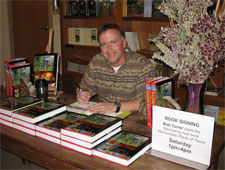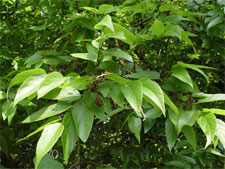Wild About Texas – January, 2009
Book Review: Remarkable Plants of Texas by M. W. Turner

Matt Warnock Turner signs copies of Remarkable Plants of Texas at a book signing hosted by the Lady Bird Johnson Wildflower Center. Photo by Andrea DeLong-Amaya.
Hot off the press! Published in January by UT Press, Remarkable Plants of Texas: Uncommon Accounts of Our Common Natives, by Matt Warnock Turner, is my new favorite book. Written to engage anyone even vaguely interested in the natural or cultural history of Texas, the elegantly woven narratives are equally captivating for laypersons and academics alike.
Discussions of more than 80 native Texas species span the 300-plus pages of text and images. “Units” of plant entries range from three to five pages, typically covering a single species, or in some cases several species that closely share stories. This simple organizational design makes it an easy read for a few long sittings or as a bedtime treat doled out one or two entries at a time.
Turner covers the breadth of plant forms from woody to herbaceous — to grasses, succulents and aquatics, imparting delicious morsels of knowledge for each entry.

Sugar hackberry (Celtis laevigata). Photo by Melody Lytle.
You might ask, for example, “What good is a hackberry tree?” Did you know that several butterflies, including the hackberry emperor, mourning cloak, and question mark, use the leaves as their sole source of nutrients during their caterpillar phase? How about that Apache Indians crafted saddles out of the wood? And I bet you didn’t know that the wood makes a good toothbrush. I tell you, you can’t go through life without the wisdom from this book!
Anything you want to know about a plant’s cultural significance and history can be found in these pages. Middens from pre-historic peoples, journals from European explorers and settlers, and information from modern-day inhabitants of Texas all contribute richness to this text. You’ll learn about medicines and toxins, textiles, building materials, ecological significance, and benefits to wildlife. You’ll get the scoop on the origins of scientific names and relish discussions about common names. Each entry includes a physical description and background on the plant’s habitat and distribution. Also useful are the glossary and the map of Native American Tribes in Texas.
The author ends his introduction by hoping that “this book will open your eyes to the remarkable stories that surround our flora, such that you never look at these plants again in the same way.” I guarantee you won’t!
Turner, Matt W. 2009. Remarkable Plants of Texas. Austin: University of Texas Press. ISBN: 978-0-292-71851-7
About the author: Andrea DeLong-Amaya is the director of horticulture at the Lady Bird Johnson Wildflower Center in Austin.
For more information about Texas native plants, visit the Wildflower Center’s website at www.wildflower.org.
